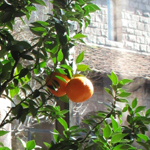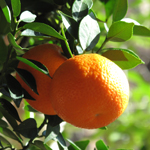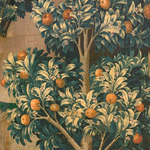Friday, October 28, 2011
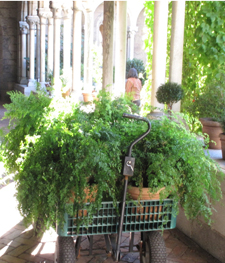
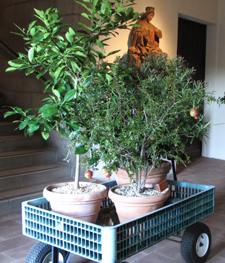
Potted plants too tender to spend the winter in Bonnefont garden are trucked inside and brought up to Cuxa cloister, which is??glazed in mid-October. Mediterranean plants such as bitter orange, myrtle, and bay laurel spend the cold season in the sunny arcades and??are brought back out to the herb garden when the glass comes down in mid-April. Left:??A wagonload of maidenhair fern in the arcade of Bonnefont garden. Right:??oranges and pomegranates en route to Cuxa cloister.?? Photographs by Carly Still
While the medieval plant collection at The Cloisters includes a good number of northern European species, a great many of the plants grown in the Bonnefont Cloister herb garden are Mediterranean in origin. Not all of these southern European plants are hardy for us here in New York City. The garden is a sheltered U.S.D.A. Hardiness Zone 7, and the fig tree (Ficus carica), poet’s jasmine (Jasminum officinale), and lavender (Lavandula angustifolia) do just fine outdoors, but more tender species like bitter orange (Citrus aurantium), rosemary (Rosmarinus officinalis), bay laurel (Laurus nobilis), and dittany of Crete (Origanum dictamnus) must be brought inside and protected from the cold. Read more »
Tags: Albertus Magnus, bay, Citrus aurantium, cucumber, cucurbit, dittany, fern, ficus carica, fig, jasmine, Jasminum officinale, laurel, Laurus nobilis, Lavandula angustifolia, Lavender, maidenhair, myrtle, orange, Origanum dictamnus, rosemary, Rosmarinus officinalis, santolina, winter
Posted in Food and Beverage Plants, Fragrant Plants, Gardening at The Cloisters, Introduction, Magical Plants, Medicinal Plants, Medieval Agriculture, Plants in Medieval Art | Comments (2)
Friday, February 18, 2011
Above: Both bitter and sweet oranges were introduced into Europe from Asia, but the bitter species preceded the sweet species by??five centuries. The bitter Citrus aurantium var. myrtifolia, a sport, or spontaneous mutation, of the medieval species suitable for pot culture, overwinters on the sunny side of the Cuxa Cloister arcade. The fruit of Citrus aurantium is economically important as a flavoring, although it is too bitter to eat out of hand. The sweet orange, Citrus sinensis, depicted in The Unicorn is Found, would have been introduced only about fifty years before the tapestry was designed.
The bitter orange, Citrus aurantium, spread from its native China to India in ancient times. The orange is mentioned in an early Ayurvedic medical text, Charaka Samhita. According to food historian Alan Davidson, the Sanskrit “naranga” became naranj in Arabic, narantsion in post-classical Greek, and aurantium in Late Latin. Albertus Magnus, the first medieval writer to describe the bitter orange, called the fruit “arangus,” from which the Italian arancia and the French and English “orange” all derive. Read more »
Tags: Ayurvedic, Charaka Samhita, Citrus aurantium, Citrus sinensis, limonaia, myrtifolia, orange, orangerie, stomachic, Tacuinum Sanitatis
Posted in Gardening at The Cloisters, Plants in Medieval Art | Comments (2)



